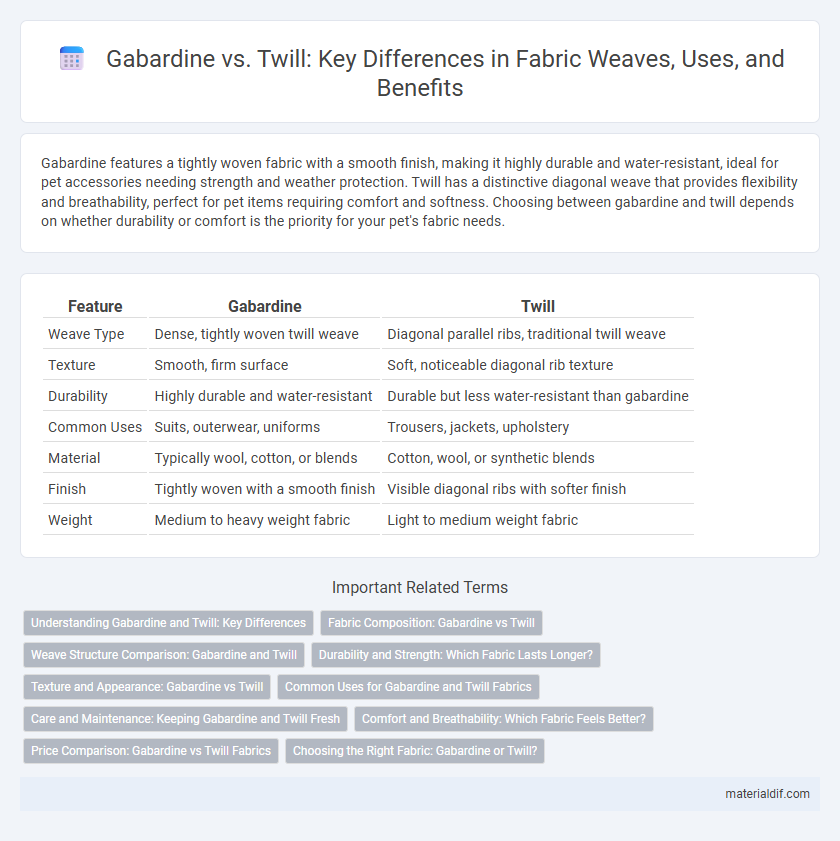Gabardine features a tightly woven fabric with a smooth finish, making it highly durable and water-resistant, ideal for pet accessories needing strength and weather protection. Twill has a distinctive diagonal weave that provides flexibility and breathability, perfect for pet items requiring comfort and softness. Choosing between gabardine and twill depends on whether durability or comfort is the priority for your pet's fabric needs.
Table of Comparison
| Feature | Gabardine | Twill |
|---|---|---|
| Weave Type | Dense, tightly woven twill weave | Diagonal parallel ribs, traditional twill weave |
| Texture | Smooth, firm surface | Soft, noticeable diagonal rib texture |
| Durability | Highly durable and water-resistant | Durable but less water-resistant than gabardine |
| Common Uses | Suits, outerwear, uniforms | Trousers, jackets, upholstery |
| Material | Typically wool, cotton, or blends | Cotton, wool, or synthetic blends |
| Finish | Tightly woven with a smooth finish | Visible diagonal ribs with softer finish |
| Weight | Medium to heavy weight fabric | Light to medium weight fabric |
Understanding Gabardine and Twill: Key Differences
Gabardine is a tightly woven, smooth fabric made from worsted wool or cotton, known for its durability and water-resistant properties, often used in suits and outerwear. Twill features a distinctive diagonal weave pattern resulting in a textured surface that enhances flexibility and hides stains, commonly found in denim, chinos, and workwear. The key difference lies in gabardine's fine, compact weave providing a sleek finish versus twill's more pronounced diagonal ribbing, impacting the fabric's appearance, feel, and performance.
Fabric Composition: Gabardine vs Twill
Gabardine is a tightly woven fabric usually made from wool, cotton, or synthetic fibers, characterized by a distinct diagonal twill weave that gives it durability and water-resistant properties. Twill fabric, on the other hand, is defined by its diagonal parallel ribs created through a weaving technique, and can be made from a variety of fibers including cotton, wool, silk, and polyester, offering versatility in texture and weight. The key difference in fabric composition lies in Gabardine's denser weave and tighter structure compared to the generally lighter and more flexible twill fabric.
Weave Structure Comparison: Gabardine and Twill
Gabardine features a tightly woven, steep twill weave characterized by diagonal ribs running at a sharp angle, resulting in a smooth, durable, and water-resistant fabric often used in suits and outerwear. Twill weave displays a more open diagonal pattern with varying angles, producing a softer, more flexible fabric commonly found in denim, chinos, and upholstery. The key difference lies in the steepness of the twill lines and density of the weave, giving gabardine a firmer hand and greater wrinkle resistance compared to standard twill.
Durability and Strength: Which Fabric Lasts Longer?
Gabardine fabric, woven with a tightly twisted twill weave, offers exceptional durability and strength, making it highly resistant to wear and tear. Twill fabric, characterized by its diagonal rib pattern, also provides robust durability but generally lacks the same level of tight weave density found in gabardine. Gabardine typically lasts longer due to its closely packed fibers and superior resistance to stretching and abrasion compared to standard twill.
Texture and Appearance: Gabardine vs Twill
Gabardine features a tightly woven, smooth texture with a distinct diagonal rib that creates a firm, durable surface, making it ideal for structured garments. Twill displays a more pronounced diagonal weave with varied patterns, offering a softer, more flexible drape and a visually textured appearance. Gabardine's fine, compact weave contrasts with twill's broader, more open weave, influencing both the fabric's finish and garment silhouette.
Common Uses for Gabardine and Twill Fabrics
Gabardine fabric is commonly used for tailored garments such as suits, trousers, and outerwear due to its tightly woven, durable nature that resists wrinkles and provides a smooth finish. Twill fabric, characterized by its distinctive diagonal weave, is often utilized in casual and workwear clothing, including jeans, jackets, and uniforms, because of its sturdy texture and resistance to abrasion. Both fabrics offer versatility, with gabardine preferred for formal attire and twill favored for rugged, everyday wear.
Care and Maintenance: Keeping Gabardine and Twill Fresh
Gabardine fabric requires gentle washing with mild detergent to maintain its smooth, tightly woven surface, while Twill benefits from routine spot cleaning to preserve its distinct diagonal weave pattern. Both fabrics should be air-dried away from direct sunlight to prevent fading and fiber damage. Proper storage using breathable garment bags helps keep Gabardine and Twill fresh and free from wrinkles over time.
Comfort and Breathability: Which Fabric Feels Better?
Gabardine offers a smooth, tightly woven texture that provides durability and slight water resistance, but it can feel less breathable and less comfortable in warmer climates compared to twill. Twill fabric, known for its distinctive diagonal weave, promotes better air circulation and softness, making it more comfortable and breathable for everyday wear. Choosing between gabardine and twill ultimately depends on desired breathability and comfort preferences in various weather conditions.
Price Comparison: Gabardine vs Twill Fabrics
Gabardine fabric, known for its tightly woven construction, often commands a higher price due to its durability and smooth finish compared to twill, which is usually more affordable with a softer texture. Twill fabric features a diagonal weave that makes it versatile and budget-friendly, commonly used in workwear and casual garments. Pricing for gabardine and twill varies based on fiber content and brand, but gabardine typically incurs greater costs in premium wool or cotton blends.
Choosing the Right Fabric: Gabardine or Twill?
Gabardine is a tightly woven, durable fabric with a smooth finish, ideal for tailored suits and outerwear requiring a polished appearance. Twill features a distinctive diagonal weave that provides flexibility and breathability, making it suitable for casual wear and workwear with enhanced comfort. When choosing between gabardine and twill, consider the desired texture, durability, and application, as gabardine offers a refined look while twill emphasizes versatility and ease of movement.
Gabardine vs Twill Infographic

 materialdif.com
materialdif.com